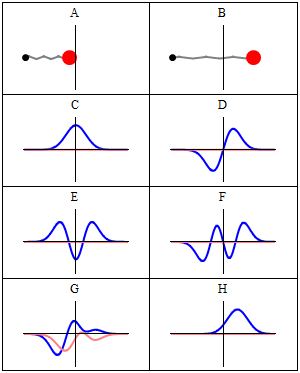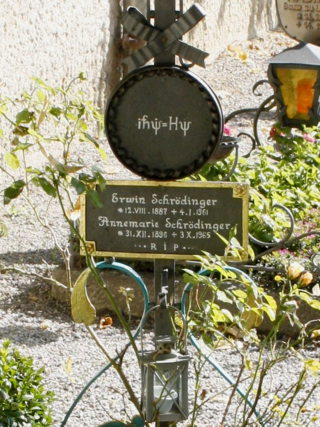Mathematical details
In the Heisenberg picture of quantum mechanics the state vectors |ψ⟩ do not change with time, while observables A satisfy

where "H" and "S" label observables in Heisenberg and Schrödinger picture respectively, H is the Hamiltonian and [·,·] denotes the commutator of two operators (in this case H and A). Taking expectation values automatically yields the Ehrenfest theorem, featured in the correspondence principle.
By the Stone–von Neumann theorem, the Heisenberg picture and the Schrödinger picture are unitarily equivalent, just a basis change in Hilbert space. In some sense, the Heisenberg picture is more natural and convenient than the equivalent Schrödinger picture, especially for relativistic theories. Lorentz invariance is manifest in the Heisenberg picture, since the state vectors do not single out the time or space.
This approach also has a more direct similarity to classical physics: by simply replacing the commutator above by the Poisson bracket, the Heisenberg equation reduces to an equation in Hamiltonian mechanics.
Equivalence of Heisenberg's equation to the Schrödinger equation
For the sake of pedagogy, the Heisenberg picture is introduced here from the subsequent, but more familiar, Schrödinger picture.
According to Schrödinger's equation, the quantum state at time  is
is  , where
, where  is the time-evolution operator induced by a Hamiltonian
is the time-evolution operator induced by a Hamiltonian  that could depend on time, and
that could depend on time, and  is the initial state.
is the initial state.  refers to time-ordering, ħ is the reduced Planck constant, and i is the imaginary unit. The expectation value of an observable
refers to time-ordering, ħ is the reduced Planck constant, and i is the imaginary unit. The expectation value of an observable  in the Schrödinger picture, which is a Hermitian linear operator that could also be time-dependent, in the state
in the Schrödinger picture, which is a Hermitian linear operator that could also be time-dependent, in the state  is given by
is given by

In the Heisenberg picture, the quantum state is assumed to remain constant at its initial value  , whereas operators evolve with time according to the definition
, whereas operators evolve with time according to the definition

This readily implies  , so the same expectation value can be obtained by working in either picture. The Schrödinger equation for the time-evolution operator is
, so the same expectation value can be obtained by working in either picture. The Schrödinger equation for the time-evolution operator is

It follows that

where differentiation was carried out according to the product rule. This is Heisenberg's equation of motion. Note that the Hamiltonian that appears in the final line above is the Heisenberg Hamiltonian  , which may differ from the Schrödinger Hamiltonian
, which may differ from the Schrödinger Hamiltonian  .
.
An important special case of the equation above is obtained if the Hamiltonian  does not vary with time. Then the time-evolution operator can be written as
does not vary with time. Then the time-evolution operator can be written as

and hence  since
since  now commutes with
now commutes with  . Therefore,
. Therefore,

and following the previous analyses,

Furthermore, if  is also time-independent, then the last term vanishes and
is also time-independent, then the last term vanishes and

where  in this particular case. The equation is solved by use of the standard operator identity,
in this particular case. The equation is solved by use of the standard operator identity,

which implies

A similar relation also holds for classical mechanics, the classical limit of the above, given by the correspondence between Poisson brackets and commutators:

In classical mechanics, for an A with no explicit time dependence,

so again the expression for A(t) is the Taylor expansion around t = 0.
In effect, the initial state of the quantum system has receded from view, and is only considered at the final step of taking specific expectation values or matrix elements of observables that evolved in time according to the Heisenberg equation of motion. A similar analysis applies if the initial state is mixed.
The time evolved state  in the Schrödinger picture is sometimes written as
in the Schrödinger picture is sometimes written as  to differentiate it from the evolved state
to differentiate it from the evolved state  that appears in the different interaction picture.
that appears in the different interaction picture.
Commutator relations
Commutator relations may look different than in the Schrödinger picture, because of the time dependence of operators. For example, consider the operators x(t1), x(t2), p(t1) and p(t2). The time evolution of those operators depends on the Hamiltonian of the system. Considering the one-dimensional harmonic oscillator,

the evolution of the position and momentum operators is given by:


Note that the Hamiltonian is time independent and hence  are the position and momentum operators in the Heisenberg picture. Differentiating both equations once more and solving for them with proper initial conditions,
are the position and momentum operators in the Heisenberg picture. Differentiating both equations once more and solving for them with proper initial conditions,


leads to


Direct computation yields the more general commutator relations,



For  , one simply recovers the standard canonical commutation relations valid in all pictures.
, one simply recovers the standard canonical commutation relations valid in all pictures.




















































